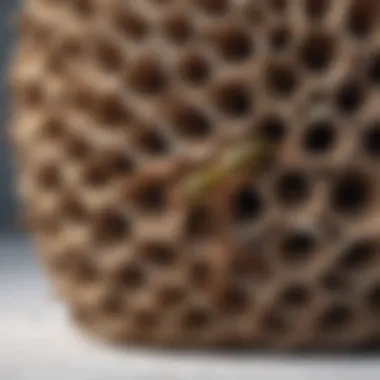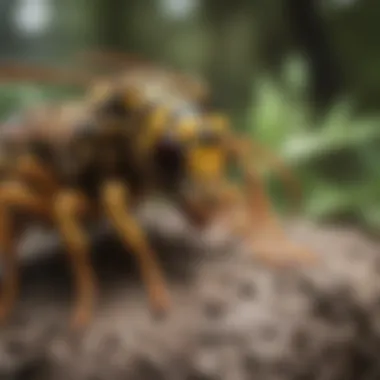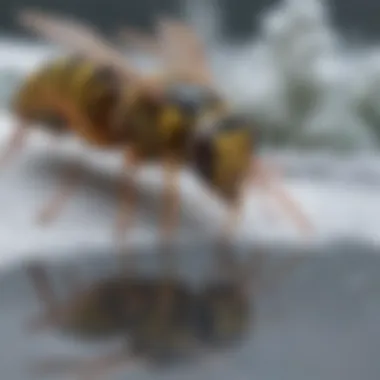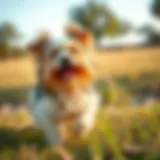Paper Wasp Nest Removal in Winter: A Comprehensive Guide


Intro
Understanding paper wasps is essential for anyone needing to manage their nests, especially in winter. This guide provides vital information for safe removal, given the unique challenges posed by the cold season. Paper wasps are known for their distinctive nests and their role in ecosystems. While they can be beneficial, their presence can pose risks to people and pets, especially in suburban areas.
Animal Species Profile
Preamble to the animal species
Paper wasps belong to the family Vespidae. There are many species of paper wasps, with the most common being Polistes dominula. These insects are social, forming colonies that can include numerous individuals. They are often recognized for their flat, umbrella-shaped nests.
Physical characteristics and appearance
Paper wasps vary in color but often exhibit a mix of yellow and black. They have long, slender bodies, which are characteristic of their family. Adult paper wasps are generally between 0.5 to 1 inch in size. Their antennae are long, helping them navigate their environment more efficiently.
Natural habitat and distribution
These wasps are commonly found in temperate regions worldwide. Their nests are typically located in sheltered spots, such as under eaves or in tree branches. They prefer areas with abundant flowers, as these locations provide necessary food sources.
Behavior and social interactions
Paper wasps are known for their social structure, where a queen leads the colony. The workers assist with nest-building and foraging for food. They communicate through various pheromones and body movements. When threatened, they can exhibit aggressive behavior, defending their nests vigorously.
Safety Considerations During Removal
Removing a paper wasp nest in winter requires careful planning to minimize risks.
Safety Tip: Always wear protective clothing and consider locating the nest at dusk when wasps are less active.
Using a proper tool such as a long pole can help. It reduces the need for close contact. Moreover, ensure to inform anyone nearby about the removal process to prevent unexpected encounters.
Methods of Nest Removal
Effective methods for removing paper wasp nests include:
- Chemical Sprays: Specialized insecticides can be effective but should be used with caution. It’s crucial to follow instructions carefully.
- Natural Solutions: Solutions like soapy water can sometimes eliminate nests with less environmental impact.
- Physical Removal: If conditions allow, you can carefully knock down the nest with a pole while wearing protective gear.
Preventive Measures
After removal, implementing preventive measures is essential. Consider:
- Sealing entry points around homes to prevent future nesting.
- Removing food sources like garbage and pet food left outdoors.
- Regular inspections in the spring when wasps start building nests.
Environmental Considerations
When dealing with pest removal, it’s important to consider local wildlife. Paper wasps can contribute to controlling insect populations. Thus, removal should align with local biodiversity efforts.
In summary, understanding paper wasps and the steps necessary for their safe removal in winter can help mitigate risks while respecting the role these insects play in the environment.
For more information on wasps and their habitats, you can visit Wikipedia or check out Britannica.
Prologue to Paper Wasps
The study of paper wasps is crucial for understanding their behavior and ways to manage nests effectively, especially during winter when these processes take on a different significance. Paper wasps, belonging to the family Vespidae, are known for their distinctive nests made from a mix of chewed wood fibers and saliva, resembling paper. This unique construction method makes it important to comprehend their nesting habits, lifecycle, and interactions with their environment.
In this article, we aim to explore the various aspects of paper wasps and their nests, particularly focusing on winter removal. By understanding their ecology and behavior, we can form more informed strategies for nest management while being aware of the potential dangers involved, such as allergic reactions or stings. The knowledge of paper wasps helps not just in effective nest removal but also in appreciating their role in our ecosystems.
Understanding Paper Wasps
Paper wasps are typically recognized by their slender bodies and long legs. Unlike other wasp species, they exhibit social behavior but do not aggressively defend their nests unless provoked.
These insects play a significant role in pest control as they prey on various garden pests, including caterpillars and aphids. While their presence may seem intimidating due to the nests they create, paper wasps contribute positively by helping maintain the balance of local ecosystems. Recognizing this duality can help mitigate fear and lead to more respectful approaches to managing their presence in human environments.


Role in Ecosystem
The ecological contributions of paper wasps extend beyond pest control. They are also involved in pollination, thus supporting biodiversity. Their nesting habits, while sometimes problematic for homeowners, aid in the decomposition process by utilizing organic materials.
It is key to understand that removing nests can disrupt local fauna. Efforts should be made to minimize negative environmental impacts. Decisions regarding nest removal should consider both immediate safety concerns and the long-term effects on garden health.
Proper understanding and management of paper wasps can lead to safer environments and encourage greater biodiversity.
Lifecycle of Paper Wasps
Understanding the lifecycle of paper wasps is essential when considering nest removal, especially during winter. Each phase of their lifecycle plays a role in their behavior and ecology, which influences both their habitat and interactions with humans. Recognizing how these insects develop can impact how and when to approach nest removal, ensuring that it is done safely and effectively.
Spring Emergence
In the spring, paper wasps emerge from hibernation. This period marks the beginning of their active phase. The queen, which survived winter, is vital during this phase. She emerges to start a new colony, laying eggs that will become worker wasps. The focus at this time is on establishing a nest and gathering food, primarily insects.
During emergence, nests are often small and vulnerable. It is crucial to identify these nests early, as paper wasps become more aggressive when they feel threatened. Removing nests during early spring can be effective, as activity is low and the risk of confrontation is reduced.
Summer Nesting Behavior
Summer is a peak time for paper wasp activity. Nests grow rapidly during this season as more workers hatch. The colony expands, and the need for foraging increases. Wasps actively target nearby plants and insects to feed the growing larvae. They may become protective of their nest, often displaying aggressive behavior towards perceived intruders.
Understanding this behavior can inform removal strategies. If removal is necessary, it is best conducted during cooler early morning hours or late in the evening when wasp activity is reduced. This timing allows one to mitigate confrontation while effectively addressing infestations.
Winter Dormancy
During winter, most paper wasps enter a dormant state. Only the fertilized queens survive, seeking sheltered locations to hibernate. The rest of the colony dies off as cold weather sets in. This dormancy is crucial as it determines the timing for nest removal. Removing nests during this period can prevent new colonies from forming in the spring.
However, care should be taken. While nests are inactive, they should not be disturbed until one is sure that all wasps are gone. Understanding this cycle helps in planning for effective removal, highlighting the importance of timing and strategy.
"Recognizing the lifecycle of paper wasps enhances safety and promotes effective management strategies during nest removal."
In summary, a clear understanding of the lifecycle stages aids in creatures' management. Evaluating spring emergence, summer activity, and winter dormancy contributes to better decision-making when it comes to paper wasp nest removal.
Safety Concerns in Nest Removal
Ensuring safety during the removal of paper wasp nests is crucial. Paper wasps can pose risks to individuals attempting to eliminate their nests, primarily due to their potential for aggressive behavior when threatened. Understanding these risks and taking appropriate precautions can significantly reduce the chances of stings or allergic reactions, making the removal process safer for everyone involved. It is not merely about the physical removal of the nest, but also about protecting one’s health and well-being during and after the task.
Identifying Allergy Risks
Allergy to wasp stings is a serious concern for many individuals. An allergic reaction can range from mild symptoms, such as itching and swelling near the sting site, to more severe responses like anaphylaxis, which can be life-threatening. It is important to assess whether anyone in the vicinity has a known allergy to wasp stings before commencing nest removal.
Key points to consider:
- Inquire among family members or neighbors about allergy history.
- Carry an epinephrine auto-injector if someone is at risk of severe allergic reactions.
- Be aware that even without a known allergy, multiple stings can induce a severe reaction in some individuals.
Required Safety Equipment
Using the right safety equipment is essential when dealing with paper wasp nests. Proper gear can help prevent stings and protect against allergic reactions. Here are the minimum safety items to consider:
- Protective Clothing: Wear long sleeves, pants, and closed shoes to cover as much skin as possible.
- Gloves: Thick gloves can provide an extra layer of protection for hands.
- Face Protection: A beekeeper's veil or a facemask can protect the face and neck, which are often the most exposed.
- Goggles: Protecting the eyes is crucial, as a sting in this area can be particularly painful.
- Spray Adhesive: This can be useful when using insecticides to immobilize wasps before removal.
By donning these safety tools, one can significantly reduce the risk involved in nest removal tasks.
Best Practices for Safe Removal
Executing best practices during the nest removal process is vital for ensuring safety. Here are some strategies for safely eliminating wasp nests:
- Choose Optimal Timing: Early morning or late evening is the best time to remove nests. Wasps are less active then, minimizing the chances of aggression.
- Station Nearby Resources: Stay close to a reliable exit path and ensure that any helpers are also positioned nearby in case of an abrupt need to retreat.
- Calm and Steady Movements: Quick or erratic movements can provoke the wasps. Move slowly and deliberately to avoid attracting attention.
- Use Chemical Sprays from a Distance: If employing insecticides, ensure you use products specifically designed for wasp control and follow manufacturer guidelines for application.
Following these safety measures can substantially reduce risks and enhance the effectiveness of the nest removal process.


- Have a First Aid Kit Ready: Always be prepared for emergencies by having a first aid kit accessible, especially one that includes allergy medication.
By taking these precautions and being aware of the risks, individuals can effectively manage the safety concerns associated with paper wasp nest removal.
Methods of Nest Removal
Understanding the methods of nest removal is crucial when dealing with paper wasp nests during winter. The importance of this section lies not only in the practicality of safe removal but also in the implications for both human safety and environmental health. Each method provides its own advantages and drawbacks, which are essential to consider before deciding the most appropriate approach.
Additionally, removing nests effectively can prevent re-infestation in subsequent seasons. This topic arms readers with knowledge and equips them for dealing with potential wasp encounters proactively.
Manual Removal Techniques
Manual removal techniques can be one of the most straightforward methods, especially when the nests are small and easily accessible.
Before engaging in this approach, several steps must be taken to ensure safety and efficiency:
- Timing: Always choose a cold winter day for this task when wasps are less active. During this time, their metabolism slows, allowing for safer access to the nest.
- Protection: It is vital to wear protective clothing, including gloves and face coverings. Even though wasps tend to be dormant, any disturbance can provoke a defensive response.
- Tools: Gather tools that can assist in the removal, such as a long-handled scraper or a garbage bag to encase the nest.
Once you are prepared and ensure your safety, gently scrape the nest from its attachment point. Place it immediately into the bag and seal it tightly.
This method is free from chemicals and can be very effective. However, inexperienced individuals may still face risks when removing larger nests or those in difficult locations.
Using Chemical Treatments
Chemical treatments are another common method for removing paper wasp nests. This approach can be effective, especially for nests that are high up or in challenging spots.
- Selecting Pesticides: Choose a pesticide specifically designed for wasp control. Common products include those containing pyrethroid, which is known for its effectiveness.
- Application Time: Similar to manual removal, applying treatments during cooler temperatures is optimal. Evening or early morning hours are often best, when wasps are less mobile.
- Safety Precautions: Use personal protective equipment, such as goggles and gloves. When applying the pesticide, maintain a safe distance, following the instructions on the label for the correct distance to spray.
Chemical treatments can provide a quick solution to the problem. Yet, they come with considerations regarding the environment. It is essential to minimize exposure to non-target species and follow the regulations for chemical use in your area.
Professional Pest Control Services
For readers who may feel overwhelmed or unsure, hiring professional pest control services is a viable method to consider.
- Expertise: Professionals have training to handle such tasks safely, providing additional peace of mind.
- Equipment: Pest control services often employ specialized equipment that allows them to access and remove nests that are difficult for homeowners to reach.
- Planning: They can create a comprehensive plan that considers both current infestations and preventions for the future.
While the costs associated with professional services might be higher than DIY options, the benefits of trained expertise and safe practices can often outweigh the price, particularly in sensitive environments or properties with multiple nests.
In summary, the method of nest removal chosen can impact not only personal safety but also local ecosystems. Weigh the options against your comfort level, resources available, and the nature of the infestation.
Timing for Winter Removal
Removing paper wasp nests in winter is a task that requires careful consideration of the timing involved. Proper timing not only ensures safety but also increases the efficacy of the removal process. Understanding the behavior of paper wasps during winter months aids in determining the most appropriate moment for intervention.
Ideal Weather Conditions
Weather plays a crucial role when removing wasp nests. Ideally, the temperature should be relatively mild, typically above 50°F (10°C), to ensure that any remaining wasps are less active. During warmer winter days, wasps may emerge briefly from dormancy, making removal easier and safer.
Additionally, it is best to choose a dry day for the removal attempt. Wet or windy conditions can cause complications, as they may make it difficult for the person attempting the removal to see clearly or handle equipment properly. Calm weather allows for better focus on the task and enhances safety, minimizing the chances of accidents.
Assessing Nest Activity
Before proceeding with nest removal, it is important to assess the current activity around the nest. During winter, many paper wasps enter a state of dormancy. However, some species may remain active on days when temperatures are warmer than usual. Observing the nest for signs of activity is essential. Look for:
- Wasps flying around the nest: This indicates that they may not be fully dormant.
- Nest conditions: Check for weather damage or signs of decay on the nest structure, which may suggest that it is less viable.
Waiting for signs of decreased activity can ensure that the nest has fewer, if any, alerted wasps. Ultimately, proper timing combines weather assessment and activity monitoring, which leads to more successful nest removal and Creates a safer environment for everyone involved.
Legal and Ethical Considerations
As the discussions surrounding pest control grow, understanding the legal and ethical considerations of paper wasp nest removal becomes increasingly significant. Many individuals may overlook these aspects, focusing solely on the urgency of the situation. However, different regions have laws in place that regulate how and when pest control can be conducted. This is not just to protect the public but also to maintain the delicate balance of local ecosystems.


Local Regulations on Nest Removal
Legislation often governs paper wasp removal to ensure that individuals do not inadvertently harm protected species. In some areas, it is illegal to remove nests without a permit, especially if they belong to a species that is threatened or endangered. Knowledge of local laws can result in better decisions that align with regional conservation efforts.
Here are a few important considerations regarding local regulations:
- Check With Local Authorities: Always consult with your municipality or local wildlife agency before removal. They can provide specific information on what is allowed.
- Permitting Requirements: Some jurisdictions require permits for nest removal, while others have strict guidelines on handling nests to protect wasps.
- Reporting Nest Locations: In certain cases, reporting a nest location might be necessary if it contains a population of a regulated species.
Environmental Impact
Removing paper wasp nests is not just about personal safety and convenience; it also raises questions regarding the environmental impact of such actions. Paper wasps play a role as predators of garden pests, helping control their populations.
- Pollinators and Biodiversity: Removing nests indiscriminately can disrupt local pollinator populations, as well as create imbalances in the ecosystem.
- Habitat Destruction: Changes in wasp populations due to removal practices can also lead to habitat changes for other species. Careful consideration is needed when making decisions about removal methods.
"Paper wasps are more than nuisances; they contribute to the ecosystem's health and stability."
Taking these legal requirements and environmental impacts into account not only demonstrates responsibility but also promotes ethical interactions with nature. By understanding and respecting local regulations regarding paper wasps, individuals can simultaneously protect their own interests and contribute to the health of local ecosystems.
Prevention of Future Infestations
Preventing future infestations of paper wasps is a critical aspect of maintaining a harmonious ecosystem around your property. As we have discussed, wasps can play a beneficial role in controlling other pests, but their nests can also pose risks to humans and pets. Therefore, taking proactive steps to deter these insects ensures that your outdoor areas remain safe and enjoyable.
Identifying Attractants
Identifying attractants is the first step in preventing paper wasps from returning. Notably, food sources are a primary attraction for these insects. Common attractants include:
- Sweet Foods: Sodas, fruit, and other sugary substances can draw in wasps during late summer and fall.
- Protein Sources: Meat scraps or pet food could also attract wasps, especially during their nesting season.
- Open Garbage: Easily accessible trash cans and compost bins provide a buffet for wasps.
It's vital to manage these sources effectively. Ensuring that food is stored securely and disposing of waste properly can significantly reduce the likelihood of wasps becoming a nuisance. Regularly monitoring the cleanliness of outdoor eating areas also contributes to the prevention strategy.
Structural Modifications
Making structural modifications to your property is another effective way to reduce the chances of attracting paper wasps. Here are several recommendations:
- Seal Cracks and Gaps: Inspect your home for openings where wasps might enter. Seal any cracks in walls or around windows to block entry points.
- Install Screens: Adding mesh screens on doors and windows can prevent wasps from accessing indoor spaces while allowing ventilation.
- Remove Unused Structures: If you have garden sheds, playhouses, or other outdoor structures that are unused, consider removing them. These can become suitable nesting sites.
By implementing these modifications, you change the landscape of your property, making it less appealing to paper wasps.
"Prevention is the best strategy when dealing with paper wasps; understanding what draws them in allows you to reduce their presence dramatically."
Ecological Impact of Nest Removal
The ecological impact of removing paper wasp nests in winter cannot be overstated. While these actions may seem necessary for safety or convenience, they can have significant consequences on local ecosystems. Understanding these implications is essential for anyone considering nest removal. The focus is on specific elements that highlight the benefits and considerations surrounding ecological impact.
Impact on Local Pollinators
Paper wasps, despite their reputation, play a critical role as pollinators. They often visit flowers and contribute to the process of pollination, which is vital for many plants, including those humans rely on. Removing their nests can disrupt their local populations. This disruption has a ripple effect, as it may reduce the pollination of various plant species and affect food sources for other animals.
- Understanding their role: Paper wasps are not the only insects that pollinate. However, they are among the numerous species that help maintain the health of ecosystems through pollination.
- Potential decline in numbers: When nests are removed, any remaining paper wasps may struggle to find suitable habitats to nest, potentially leading to declines in their populations. This decline can jeopardize pollination efficiency across different plant species.
Balance in Biodiversity
Biodiversity stands as a cornerstone of healthy ecosystems. The removal of paper wasp nests may lead to unforeseen repercussions, disturbing the balance within the ecosystem. Each species, including paper wasps, fulfills a unique role. Therefore, their removal can lead to a cascade of environmental effects that may not be immediately apparent.
- Predatory behavior: Paper wasps are known for their predatory habits, preying on various pest insects. Their absence may result in a spike in pest populations, which can harm plants and cause economic damage to agriculture.
- Niche competition: Removing paper wasps can create opportunities for other species, possibly invasive species, to take their place. This competition can alter local dynamics, potentially disadvantaging native wildlife.
"Each species, no matter how small, plays a role in maintaining ecological balance. Careful consideration must be taken before removing any species from its native habitat."
Epilogue
Understanding the process of paper wasp nest removal in winter is more than just a task to manage pests. It involves appreciating the complex role these insects play in our ecosystem and taking informed actions that align with both human safety and environmental stewardship. This article emphasizes that even in the winter months, when wasps are less active, certain considerations remain crucial.
Summary of Key Points
- Recognizing the Lifecycle: Paper wasps exhibit specific behaviors in winter, mainly dormancy. Awareness of their lifecycle aids in effective removal without unnecessary harm.
- Safety First: Allergies to wasps can pose serious health risks. Prior knowledge of safety equipment and practices is essential.
- Effective Methods: Different techniques for nest removal exist, including manual methods and chemical treatments. Each comes with its own set of advantages and disadvantages, which must be weighed carefully.
- Legal and Ethical Considerations: Understanding local regulations helps ensure that any removal actions comply with wildlife protection laws, thus maintaining environmental balance.
- Prevention Techniques: Identifying attractants and making structural adjustments to one’s property can significantly reduce future infestations, fostering a harmonious living space.
Further Resources for Readers
For readers seeking more information, several reputable sources provide additional insights on this subject:
- For a basic understanding of paper wasps, check out Wikipedia.
- To explore their ecosystem role, visit Britannica.
- Engaging discussions and experiences can be found on various community forums like Reddit.
- Connect with local wildlife groups through platforms like Facebook to learn and contribute to local conservation efforts.







